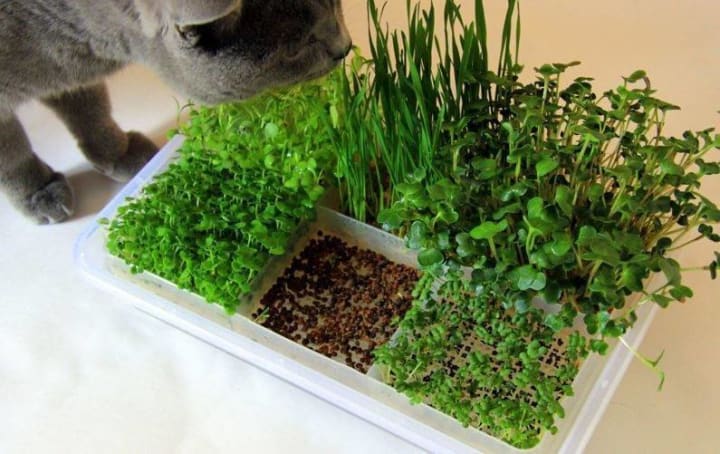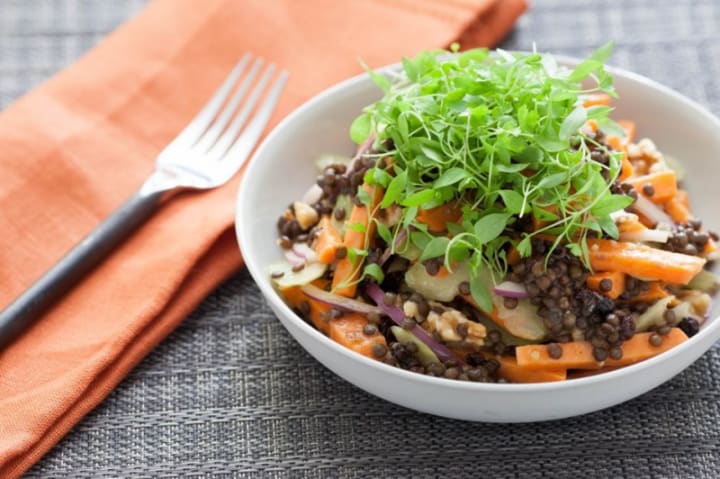7 benefits why should you add microgreens to your diet?
Home greenhouses and micro-greenery gardens on the windowsill will not surprise anyone.

Home greenhouses and micro-greenery gardens on the windowsill will not surprise anyone. The trend is growing or sprouting seeds for food consumption. The secret of popularity is that micro-greens in proper nutrition are delicious, healthy and inexpensive.
A variety of salad greens is the simplest thing that you can grow on your windowsill all year round. Agree, it is easier to grow yourself than to buy. Not to mention the fact that you will be sure that there is no chemical treatment of such greens. It’s time to diversify your menu with the most helpful and delicious innovations — we are talking about microgreen.
Vitamins on the windowsill
Microgreen — crops that contain healthy substances at an early age, ten times more than their presence in adult plants, and together with the technology of closed light culture, useful substances in microgreen are concentrated in the maximum possible peak.
The aroma and taste of micro-greens is very piquant and it brings its own zest to the usual dishes, and the color of the petiole will become a kind of decoration. Green, purple and reddish leaves and petioles will create a unique flavor when serving daily and festive dishes and snacks.

It would seem that this is just a small green, but no. She has a big secret. If you introduce micro-greens into your diet, you will not only feel more cheerful and kinder, you will also become younger!
You will begin to slow down the aging process, because micro-greens contain a huge amount of antioxidants and chlorophyll, which fight oxidation, which eventually leads to premature aging of the body’s cells. As the beginning of a new life — a new plant — microgreen rejuvenates, energizes and heals the body. In addition, these sprouts are very young and do not have time to accumulate harmful substances that negatively affect our health.
Three types of microgreens
Sprouts-use sprouted seeds before the cotyledon phase. Sprouts are a healthy and low-calorie food.
Microgreens young plants use seedlings with a well-developed hypocotyl, cotyledonous leaves and the beginning of the growth of the second real leaf. In winter or spring, when the lack of sun and vitamins deprives you of strength, microgreens will help.
Microgreens of some types look very beautiful and can be used not only as a healthy supplement in your diet, but also as a full-fledged decoration of the dish. For example, amaranth sprouts are very tender and look
amazing. Beetroot sprouts have a less intense flavor, but they also have a great look for decorating a dish. Bright peas, thanks to the tendrils, have a unique look.
All cut micro-greens can be safely stored on the bottom shelf of the refrigerator for one to two weeks, if you first put it on a wet cloth.
Young plants-use plants in the phase from two to the formation of 4–5 of the present leaf. From a purely taste point of view, young plants are able to give a salad or any other dish a special piquancy and unique taste.

The use of sprouts
Lovely to look at and pleasant to the taste sprouts are extremely beneficial for health. Each of them contains the nascent potential of the future vegetable or cereal. Microgreen is always a fount of vitamins and microelements, as well as gentle fiber. Since the plant is at the very beginning of its growth and formation, the concentration of useful substances in it is the greatest, since nature actively saturates it with forces.
In winter or spring, when the lack of sun and vitamins deprives you of strength, microgreens will help:
It has a beneficial effect on digestion;
To cope with the constant fatigue;
Restore the balance of vitamins and trace elements;
Strengthen the nervous system;
Boost your energy;
Give strength and efficiency;
To jump-start the immune system.
In addition to the excellent taste, microgreens have an unusually high nutritional value. They are full of all sorts of vitamins such as C, E and K, along with the phytonutrient carotenoid, which has been shown to support immune function.
Note that all vitamins are contained here in record amounts, but
among the vitamins, the presence of vitamin C, known for its antioxidant properties, is especially valuable. In addition, the carotenoids contained in young plants during their active growth fight free radicals that destroy the body’s cells.

A 2014 study conducted by the U.S. Department of Agriculture examined 25 varieties of microgreens, testing how their nutrients differ from those of typical vegetables. According to their report, “ overall, microgreens contained significantly higher levels of vitamins and carotenoids about five times more-than their mature plant counterparts, indicating that microgreens may be worth delivering fresh during their short lives.” — https://agresearchmag.ars.usda.gov/2014/jan/greens
For growing microgreen fits a great variety of seeds and grains. They are sold in raw food stores, for example, or on the shelves of large supermarkets. Among them are many seeds from Eastern cuisine.
To grow microgreen not as expensive as it might seem at first glance. A few tablespoons of seeds grow into a good portion of fresh greens. It is not worth sprouting too much microgreen at a time, because the fresher it is, the more valuable it is, and over time it can completely wither. In wilted seedlings, of course, at times less vitamins and trace elements than fresh, juicy, just grown.
Microgreen serves salads and the second dishes. This is a wonderful, sometimes very spicy side dish to meat, fish dishes, as an addition to sandwiches and salads of vegetables, fruits, cheese, seafood. Sprouts adorn the dish very much both externally and in terms of taste. Microgreen nice to add to shakes and smoothies.

The most popular types of micro-greenery
For growing miniature greens, any crops are suitable. The most popular — seeds of cereals, spicy aromatic herbs, salads, cruciferous (cabbage, radish, daikon, mustard), legumes. By the way, all this is not only useful and delicious, but also beautiful.
Some in the sprouted form have a sharp or tart taste, a pronounced aroma: radish, daikon, mustard, coriander, dill, parsley. Peas, oats and wheat, corn, cabbage (most often broccoli), beets, chard have a neutral taste. The sweet aftertaste gives buckwheat, sunflower seeds, chia seeds.
Sprouting spicy herbs
Aromatic herbs are needed not only for the pleasant smell that they give to food. Essential oils, acids, minerals, tannins — in a healthy diet, you can not do without them. All of them are useful for maintaining the overall health of the body.
In addition to the traditional dill and parsley, you must grow basil, arugula, marjoram. Their aroma and spicy taste are a pleasant addition to the benefits! Amaranth and flax are not spicy, but their useful properties are no less.

Legumes on the windowsill
To plant legumes on greens means to provide your body with proteins and phosphorus, B vitamins, vitamin C, PP, E, K. Peas and lentils are leading in popularity among other relatives-beans. They give green growth quickly and a lot. Juicy sprouts are not only useful, but also pleasant to the taste. You can plant them in separate containers or mix them in one.
Salads for salads
Lettuce or watercress is not necessary to buy in a supermarket or vegetable shop. Without much effort and expense, they can be grown at home.
Cutting the crop a week after planting, you can immediately plant the next batch. Salad greens are already firmly established in the diet of those who adhere to a healthy lifestyle.

Vegetable crops in the mini-garden
From vegetable crops, various varieties of cabbage (red cabbage, broccoli), carrots, beets and chard (a leafy relative of beets) are chosen. In addition to vitamin supplementation of the body, they are useful for the hematopoietic system and digestive system. They have a beneficial effect on the condition of hair and nails, making them strong and beautiful.
There are no really dangerous properties of microgreens, but when using it, you need to take into account the characteristics of your body and contraindications — they are present in any product or plant. The first and most important rule is that the measure must be in everything.
Watch how seeds of plants are hatched in mini-vegetable gardens, collect the first crop of greens, please yourself and your loved ones with them. There is something ancient, magical in all this, that came to us from our distant ancestors. After the first experience of growing micro-greenery, it is already very difficult, almost impossible to stop.
© 2021 Elena Petrova
About the Creator
Elena Sunshine Magazine
Fresh ideas every day.






Comments
There are no comments for this story
Be the first to respond and start the conversation.